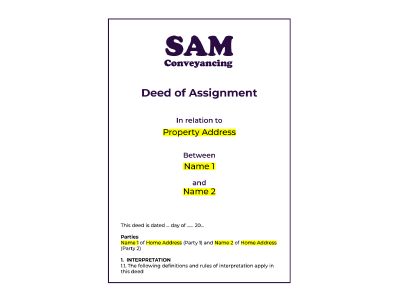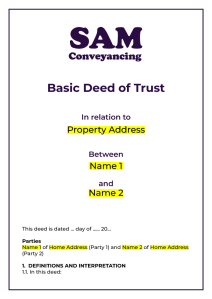Deed of Assignment for Beneficial Interest in Property
For buy-to-let landlords seeking to optimise their property income tax, a Deed of Assignment allows you to assign an equitable interest in land or property to another party. Equitable interest is also known as beneficial interest.
It's most commonly used between spouses to share property income tax-efficiently but it's important to note that you can only assign beneficial interest if you own the property solely or as Tenants in Common. If the property is held as Joint Tenants, you must first sever the joint tenancy.
You also have the flexibility to assign any amount of the beneficial interest, from 100% down to 1%. Given the significant financial implications, all parties involved must seek Independent Legal Advice before signing a Deed of Assignment.
When to use a Deed of Assignment
You would use a Deed of Assignment instead of a Deed of Trust if the relationship is spousal (husband and wife, civil partners). Any dispute over ownership falls under Family Law because you are married or civil partners.
A Deed of Trust is better for any other relationship as it can be drafted to protect the individual interest of the parties outside of the percentage ownership of property income.
Spouses can use a Deed of Assignment to share property income in a manner that suits their individual income tax position for the rental income and Capital Gains Tax or as part of Inheritance Tax planning.
The assignment of the beneficial interest doesn't change the names of the legal owners at the Land Registry, and you can assign however much you see fit.
Deed of Assignment format
The Deed of Assignment format will depend on the transaction details and what is agreed between the Assignor, the party giving the equitable interest, and the Assignee, the party receiving it. A deed should include:
- Background. Details of the transaction between the Assignor and Assignee;
- Assignment. What is being assigned, including any consideration (what is being exchanged, often nominal) for the assignment;
- Costs. The parties agree on who is to cover the legal costs for drafting the deed; and
- Notice of Assignment. Written confirmation that the assignment of equitable interest has been executed as a deed.
Share rental income or transfer property ownership quickly and easily with a Deed of Assignment.
Get your first draft within 1-2 working days*.
Our experienced solicitors draft deeds for various purposes, from buy-to-let transfers to protecting your interest in the family home.
- Transfer rental income efficiently.
- Assign Capital Gains securely.
- Transfer full or partial ownership seamlessly.
When can't you use a Deed of Assignment?
You can't assign a beneficial interest until the assignor is registered as the legal owner at the Land Registry. This is because until the Assignor's ownership is officially recorded, they don't have a recognised legal basis to transfer any interest in the property.
Also, remember that a Deed of Assignment is used when the property is owned solely or as Tenants in Common. If the property is held as Joint Tenants, the Joint Tenancy must be severed before a beneficial interest can be assigned.
Additionally, there might be restrictions on assigning beneficial interest in several other situations relevant to buy-to-let landlords. For example:
- Your mortgage agreement may require the lender's permission before you can assign any beneficial interest.
- If the property is leasehold, the terms of the lease could restrict or prevent assignment.
- If the property is owned through a more complex ownership structure, such as certain types of trusts, the rules for assigning beneficial interest might be different.
- If there are other legal charges or restrictions registered against the property title, these could also affect your ability to assign beneficial interest.
It's always crucial to carefully review your property documents, including your title deeds, mortgage agreement, and lease (if applicable), or seek legal advice to understand any potential limitations on assigning beneficial interest.
Would you like to assign interest to anyone OTHER than your legal spouse? It could be a partner, family friend, or business associate.
The first draft is within 1 to 2 working days(i) and includes:
- Deposit paid.
- The percentage ownership of each party.
- How to share expenses like the mortgage and bills.
- Share of property income - rent or gain on sale.
- How to sell the property.
- How the property is divided in the event of separation, divorce, or death.
Is a Deed of Assignment suitable for a Form 17 declaration?
Yes, it is, as Form 17 states:
"If you live together with your spouse or civil partner, we normally treat income from property held in your joint names as if it belonged to you in equal shares and tax each of you on half of the income, regardless of actual ownership.
Please complete this form if you want to be taxed on your actual shares (known as `actual basis'). You'll also need to provide evidence that your beneficial interests in the property are unequal, for example, a declaration or deed."
Andrew started his career in 2000 working within conveyancing solicitor firms and grew hands-on knowledge of a wide variety of conveyancing challenges and solutions. After helping in excess of 50,000 clients in his career, he uses all this experience within his article writing for SAM, mainstream media and his self published book How to Buy a House Without Killing Anyone.
Caragh is an excellent writer and copy editor of books, news articles and editorials. She has written extensively for SAM for a variety of conveyancing, survey, property law and mortgage-related articles.











